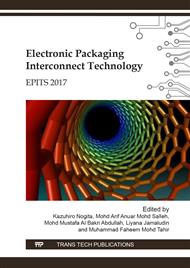p.3
p.9
p.14
p.20
p.27
p.34
p.40
p.46
Effect of Trace Phosphorus on the Dross Formation in Tin-Copper-Nickel Wave Solder
Abstract:
Additions of trace elements such as Phosphorus (P) and Germanium (Ge) are common practice to improve the oxidation resistance in Tin-Copper (Sn-Cu) wave solder systems, however, little insights are available regarding their combined role. In this article, the effect of trace P (<100ppm), in the presence of Ge (<100ppm), on the phase composition and microstructure of Sn-Cu-Ni wave solder dross is studied using various techniques including Synchrotron XRPD, SEM, FIB and TEM. We find that P additions, in the presence of Ge, result in the formations of SnO, SnO2 and Ni2SnP intermetallic in the dross whereas only SnO is present in the P-free equivalent. The crystal structure of Ni2SnP is identified as orthorhombic with the space group Pnma. Based on the findings, it is evident that P not only influences the oxidation state of tin oxides but also reduces the concentration of effective Ni in the alloys via the formation of Ni2SnP intermetallic.
Info:
Periodical:
Pages:
9-13
Citation:
Online since:
April 2018
Keywords:
Price:
Сopyright:
© 2018 Trans Tech Publications Ltd. All Rights Reserved
Share:
Citation:


